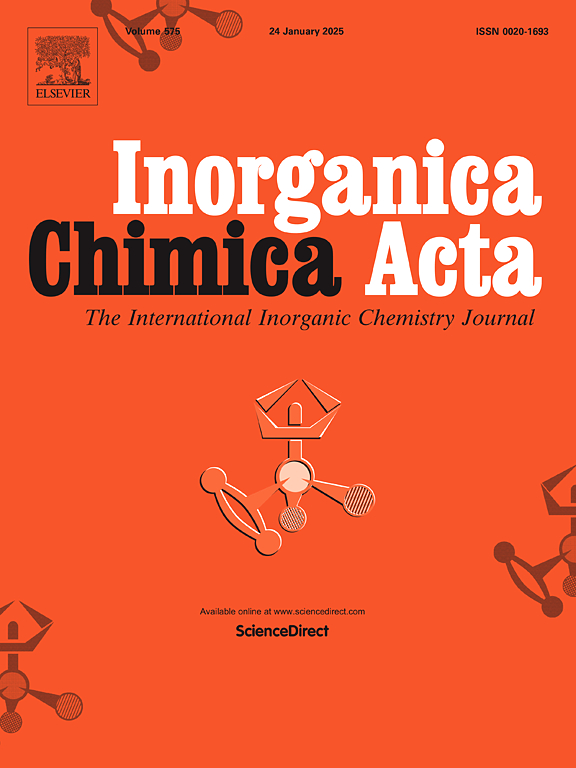8-羟基喹啉超分子堆积镝配合物的合成、结构和磁性研究
IF 3.2
3区 化学
Q2 CHEMISTRY, INORGANIC & NUCLEAR
引用次数: 0
摘要
本文报道了三种DyIII配合物,即[Dy3(ql)8Cl(Hql)]·3CH3OH·H2O (1;Hql = 8-羟基喹啉),[Dy3(ql)7(NO3)2(Hql)]·3CH3CN(2)和[Dy2(ql)3(Xa)(NO3)2(CH3OH)2(H2O)] (3, HXa =杂蒽-9-羧酸)。1和2都具有准线性的三核团簇结构,而3具有双核结构。值得注意的是,不同的分子间π-π相互作用导致了三个体系的结构变化,形成了1和3的超分子二聚体,以及2的超分子二维蜂窝状框架。磁性研究表明,1和3表现出场诱导的双重弛豫行为。慢弛豫过程的有效能垒仅为3.0 K和2.1 K。相反,2表现出零场弛豫行为,具有140 K的有效能垒。这项工作强调了配体场工程和π-π堆叠相互作用如何协同调节镧系单分子磁体系统中的弛豫动力学。本文章由计算机程序翻译,如有差异,请以英文原文为准。

Synthesis, structures and magnetic properties of π-stacked supermolecular dysprosium(III) complexes with 8-hydroxyquinoline
In this work, we report three DyIII complexes, namely, [Dy3(ql)8Cl(Hql)]·3CH3OH·H2O (1; Hql = 8-hydroxyquinoline), [Dy3(ql)7(NO3)2(Hql)]·3CH3CN (2) and [Dy2(ql)3(Xa)(NO3)2(CH3OH)2(H2O)] (3, HXa = xanthene-9-carboxylic acid). Both 1 and 2 feature quasi-linear trinuclear cluster structures, while 3 has a dinuclear structure. Significantly, diverse intermolecular π-π interactions led to the structural variety in three systems, forming supermolecular dimers of 1 and 3, and a supramolecular 2D honeycomb-like framework of 2. Magnetic studies demonstrate that 1 and 3 exhibit field induced dual relaxation behavior. The efficient energy barriers for their slow relaxation processes are only 3.0 and 2.1 K. In contrast, 2 displays zero-field relaxation behavior, with an efficient energy barrier of 140 K. This work highlights how ligand field engineering and π-π stacking interactions synergistically modulate relaxation dynamics in lanthanoid single-molecule magnets systems.
求助全文
通过发布文献求助,成功后即可免费获取论文全文。
去求助
来源期刊

Inorganica Chimica Acta
化学-无机化学与核化学
CiteScore
6.00
自引率
3.60%
发文量
440
审稿时长
35 days
期刊介绍:
Inorganica Chimica Acta is an established international forum for all aspects of advanced Inorganic Chemistry. Original papers of high scientific level and interest are published in the form of Articles and Reviews.
Topics covered include:
• chemistry of the main group elements and the d- and f-block metals, including the synthesis, characterization and reactivity of coordination, organometallic, biomimetic, supramolecular coordination compounds, including associated computational studies;
• synthesis, physico-chemical properties, applications of molecule-based nano-scaled clusters and nanomaterials designed using the principles of coordination chemistry, as well as coordination polymers (CPs), metal-organic frameworks (MOFs), metal-organic polyhedra (MPOs);
• reaction mechanisms and physico-chemical investigations computational studies of metalloenzymes and their models;
• applications of inorganic compounds, metallodrugs and molecule-based materials.
Papers composed primarily of structural reports will typically not be considered for publication.
 求助内容:
求助内容: 应助结果提醒方式:
应助结果提醒方式:


